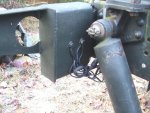hawkeyepoole
New member
- 51
- 2
- 0
- Location
- Keller, TX
I noticed that the right turn/brake light on the rear of my M35A2C wasn't working. I assumed that it was a burned bulb, so I pulled the cover and swapped the bulb to the other side to see. It worked just fine. So then I figured for some reason, there's no power to the socket. Maybe a broken wire somewhere.
I put a voltmeter in the socket and found 24 volts flashing on and off just like the left side. I tried swapping the bulbs. Both work, but neither works in the right side. I cleaned the socket, tried adding a bit of solder to the center contact of the bulb, in case that was an issue.
NOTHING!
There is 24 volts at the socket, yet the bulb will not light! How can that be? I put my voltmeter contacts on the socket and see the voltage pulsing with the flashers on.
Weird as ****, and I'm at a loss! I'd hate to have to buy a tail light when this one appears to work, except it doesn't....
I put a voltmeter in the socket and found 24 volts flashing on and off just like the left side. I tried swapping the bulbs. Both work, but neither works in the right side. I cleaned the socket, tried adding a bit of solder to the center contact of the bulb, in case that was an issue.
NOTHING!
There is 24 volts at the socket, yet the bulb will not light! How can that be? I put my voltmeter contacts on the socket and see the voltage pulsing with the flashers on.
Weird as ****, and I'm at a loss! I'd hate to have to buy a tail light when this one appears to work, except it doesn't....





